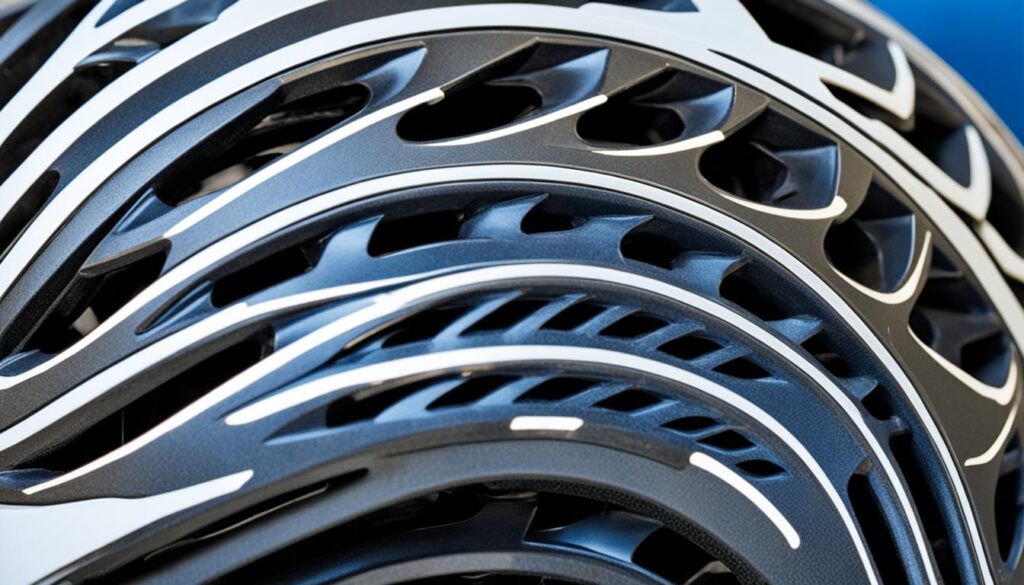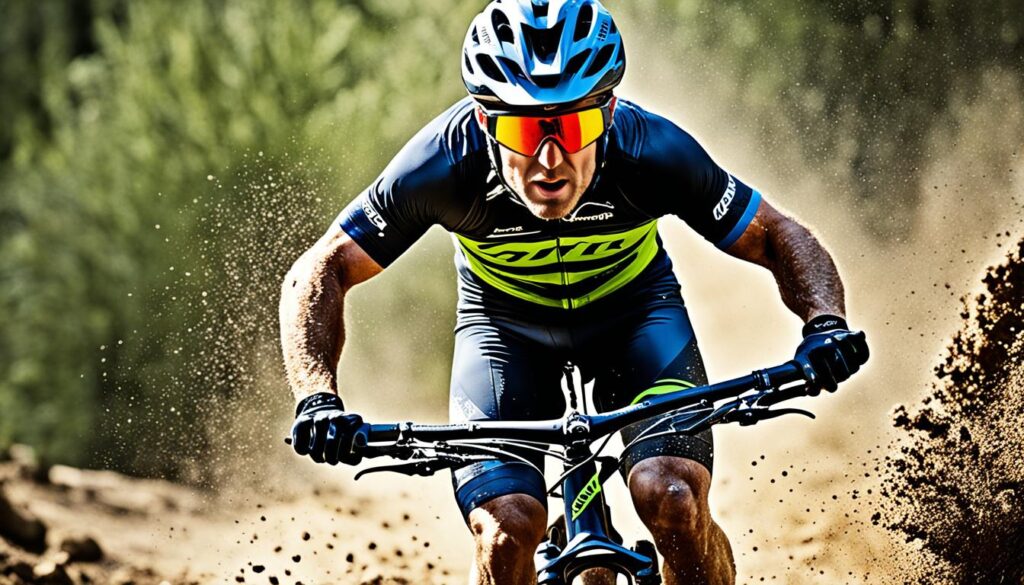
When it comes to mountain biking, safety should always be a top priority. And nothing is more crucial for your protection than a reliable mountain bike helmet. But with so many options out there, how do you know which features are essential for your helmet? Are there any innovative features that can enhance your riding experience? Let’s dive into the world of mountain bike helmet features and find out what makes the best ones truly stand out.
Key Takeaways:
- Understanding the different types of mountain bike helmets and choosing the right one for your riding style.
- The importance of extended coverage and rotational impact protection systems in half-shell helmets.
- Considerations for helmet fit, adjustments, and strap harness to ensure a secure and comfortable fit.
- Weighing the balance between helmet weight and protection levels.
- The role of ventilation and cooling in keeping your head comfortable during rides.
Types of Mountain Bike Helmets
When it comes to mountain biking, choosing the right helmet is crucial for rider safety and protection. Mountain bike helmets can be categorized into two main types: full-face and half-shell helmets.
Full-face mountain bike helmets: These helmets provide complete coverage for the head, including a chin and face guard. They offer the highest level of protection, making them ideal for more aggressive riders, such as downhill and BMX enthusiasts.
Half-shell mountain bike helmets: These helmets offer less coverage compared to full-face helmets and focus on protecting the top, sides, and back of the head. They are the most popular and versatile option for mountain bike riders, suitable for various disciplines like cross-country, trail, all-mountain, and enduro riding.
For most riders, half-shell helmets provide adequate protection and comfort for their biking needs. They strike a balance between protection and lightweight design, allowing for better ventilation and ease of movement on the trails.
When choosing a mountain bike helmet, consider the type of riding you’ll be doing, your skill level, and the level of protection required to ensure a safe and enjoyable biking experience. Whether you prefer the full-face or half-shell design, it’s important to prioritize your safety on the trails.
Half-Shell Mountain Bike Helmets
When it comes to mountain biking, half-shell helmets are the go-to choice for the majority of riders. These versatile helmets are suitable for various riding styles, including road biking, commuting, pump track sessions, and trail riding. Half-shell mountain bike helmets strike a balance between protection, weight, ventilation, and features, making them a favorite among trail riders.
The best half-shell helmets offer extended coverage for the sides and back of the head, ensuring enhanced safety during falls and impacts. This extended coverage provides added protection where it matters most, helping to minimize the risk of injuries. Additionally, many half-shell helmets are equipped with a rotational impact protection system, such as the popular MIPS (Multi-directional Impact Protection System), which helps reduce rotational forces on the brain during certain impacts.
Comfort and fit are key considerations for any cyclist, and half-shell helmets deliver on both fronts. These helmets often feature an adjustable fit system, allowing riders to customize the helmet’s fit to their preferences. This ensures a secure and comfortable feel, even during long rides. The secure fit prevents the helmet from shifting or sliding, providing reliable protection without compromising comfort.
Furthermore, half-shell mountain bike helmets offer excellent ventilation to keep riders cool and comfortable. Ventilation systems with strategically placed vents promote airflow, preventing heat build-up and allowing sweat to evaporate efficiently. This feature is particularly beneficial during intense rides or in warmer climates.
Half-shell mountain bike helmets provide a balanced combination of extended coverage, rotational impact protection, comfort, and ventilation. These helmets are designed to meet the demands of trail riders, making them a popular choice among mountain bike enthusiasts.
Mountain Bike Helmet Review: Finding the Perfect Fit
When searching for the ideal mountain bike helmet, it’s crucial to consider factors beyond just style and aesthetics. Half-shell helmets with extended coverage, a rotational impact protection system, and an adjustable fit provide the necessary features for optimal safety and comfort on the trails. Whether you’re a dedicated trail rider, a commuter, or an occasional mountain biker, choosing a high-quality half-shell mountain bike helmet is a wise investment in your biking experience.
Helmet Protection and Safety Features
The primary function of a mountain bike helmet is to protect your head in the event of an impact. Choosing a helmet that offers adequate coverage and protection is crucial for your safety on the trails.
Half-shell mountain bike helmets have evolved to provide more coverage, with shells extending lower on the sides and back of the head. This extended coverage helps protect vulnerable areas during a crash or collision.
Innovative safety features have also been integrated into modern helmets to enhance their protective capabilities. One such feature is the MIPS (Multi-directional Impact Protection System) technology, which has been widely adopted by many helmet manufacturers. MIPS technology works by reducing rotational forces on the brain during certain impacts, reducing the risk of brain injuries.
“MIPS technology reduces rotational forces on the brain during certain impacts, enhancing helmet safety.”
In addition to MIPS, other helmet manufacturers have developed their own proprietary rotational impact protection systems. These systems aim to provide similar benefits in minimizing the rotational forces transmitted to the head during an angled impact.
When choosing a helmet, it’s important to consider both the coverage and the safety features it offers. Look for helmets with extended coverage to ensure greater protection for the sides and back of your head. Additionally, consider helmets equipped with MIPS technology or other rotational impact protection systems to enhance your safety on the trails.
Remember, wearing a helmet is an essential part of responsible mountain biking. By investing in a helmet with adequate protection and safety features, you can ride with confidence, knowing you’ve taken the necessary steps to protect yourself.
Proper Fit and Adjustments
A properly fitting helmet is essential for optimal comfort and protection when riding your mountain bike. To ensure the best fit, start by measuring the circumference of your head with a tape measure. Use this measurement to select a helmet size that falls within the recommended range for your head size.
Modern helmets come equipped with adjustable straps and fit adjustment systems, allowing you to customize the fit to your specific needs. The straps can be adjusted under the chin and below the ears to achieve a secure and snug fit. It’s important to ensure that the straps are not too loose or too tight, as this can affect both comfort and safety.
The fit adjustment system, often in the form of a dial, allows for fine-tuning of the fit by tightening or loosening the helmet around the head. This feature enables you to find the perfect balance between comfort, stability, and protection. Adjust the fit tension according to your preference, ensuring that the helmet remains secure during your ride.
Once you have adjusted the straps and fine-tuned the fit using the adjustment system, it’s crucial to properly tighten the strap harness. The strap harness plays a vital role in keeping the helmet securely in place in the event of a crash or impact.
Remember, a helmet that doesn’t fit correctly may compromise both comfort and safety. Take the time to ensure that your helmet is properly adjusted before heading out on your mountain bike. By following these fit adjustment guidelines, you can ride with confidence knowing that your helmet provides the necessary protection for your adventures.
Weight Considerations
When it comes to choosing a mountain bike helmet, weight is a crucial factor to consider, especially for weight-conscious riders and those participating in cross-country racing. A lighter helmet can make a significant difference in overall comfort, especially during long rides.
While the weight difference between various half-shell helmets may not be extreme, every ounce counts when it comes to reducing fatigue and enhancing your riding experience. A lightweight helmet allows you to focus on the trail ahead without feeling weighed down.
However, it’s important to strike a balance between weight and protection. Some riders prioritize maximum protection and may opt for full-face or enduro-style helmets, which offer additional coverage and impact resistance at the expense of increased weight.
Ultimately, the choice between a lightweight helmet and one that provides more coverage depends on your personal preferences and riding style. If you prioritize comfort and weight reduction, a lightweight half-shell helmet is a great option. On the other hand, if you’re tackling more aggressive trails or engaging in high-risk riding disciplines, a helmet with additional coverage might be a better fit.
Remember that the most important aspect of a helmet is its ability to protect your head in the event of a crash or impact. So, regardless of weight considerations, always prioritize a helmet that meets safety standards and offers adequate protection.
Ventilation and Cooling
One of the most critical features to consider when choosing a mountain bike helmet is ventilation. Proper airflow and cooling capabilities are essential, particularly in warmer climates or during intense rides. The number and size of vents in a helmet play a significant role in determining its ventilation system’s effectiveness.
A well-ventilated helmet ensures your head stays cool and comfortable, minimizing heat build-up and excessive sweating. The constant flow of air helps regulate temperature and prevents discomfort during long rides. When selecting a helmet, take into account your riding environment and personal preference for ventilation levels.
In cooler climates, riders may choose helmets with fewer vents to maintain warmth during colder rides. On the other hand, riders in hot and humid conditions or who engage in high-intensity activities may prefer helmets with multiple strategically placed vents to maximize airflow. Choosing a helmet with the appropriate level of ventilation will enhance your overall riding experience and comfort.
If we look at the different factors, it can be seen that helmet ventilation is a crucial feature for riders. Proper airflow and cooling help regulate temperature and prevent discomfort during rides.
Maximizing Airflow and Cooling
Manufacturers design mountain bike helmets to optimize ventilation, with vents strategically placed to maximize airflow. The shape and design of the vents also contribute to enhanced cooling. Some helmets feature larger front vents to allow cool air to enter and circulate around the head, while rear vents facilitate hot air’s efficient exit.
The airflow created by the vents not only cools your head but also reduces moisture build-up, preventing sweat from interfering with your vision and comfort. A well-ventilated helmet ensures that you can maintain focus on the trail without distractions.
To give you an idea of how helmet ventilation can improve your riding experience, consider this: as the cool air circulates around your head, it dissipates excess heat, making your rides more enjoyable and enduring.

Safety Standards and Certifications
Helmets must meet established safety standards and certifications to ensure they provide adequate protection for riders. Various safety standards and certifications are used worldwide, such as the CPSC (Consumer Product Safety Commission) certification in the USA and the CE EN1078 certification in Europe. These certifications indicate that helmets have undergone rigorous testing and meet or exceed industry safety standards.
Manufacturers are required to adhere to these standards and certifications to ensure their helmets are safe for use. This includes rigorous testing of materials, construction, and performance to ensure they can withstand the impact forces associated with cycling accidents.
CPSC Certification
The CPSC certification is required for all helmets sold in the United States. This certification ensures that helmets meet the safety standards set by the Consumer Product Safety Commission. Helmets that pass CPSC testing provide a certain level of protection against impact forces, penetration, and chin strap strength. Look for the CPSC certification label when purchasing a helmet to ensure it meets these safety standards.
CE EN1078 Certification
The CE EN1078 certification is the European standard for bicycle helmet safety. Helmets that meet this certification have undergone testing to determine their ability to absorb impact energy, provide adequate coverage, and stay securely on the head during an accident. The CE EN1078 certification label indicates that the helmet meets the requirements set by the European standard.
When choosing a helmet, it is essential to look for these safety certifications. They provide assurance that the helmet has been tested and meets the necessary safety standards. Whether you are a professional cyclist or a recreational rider, having a helmet that meets safety standards is crucial for your protection on the road or trail.
Helmet Style and Aesthetics
The style and aesthetics of a mountain bike helmet are important considerations that can greatly enhance your riding experience. When it comes to helmets, there are various designs, colors, and finishes available, allowing you to find one that matches your personal style and complements your biking gear.
Whether you prefer a sleek and modern look or a bold and vibrant design, there is a helmet that can make you stand out on the trails. From minimalist designs to eye-catching patterns, the options are endless. A well-designed helmet not only provides excellent protection but also adds a touch of personality to your overall biking ensemble.
Some riders may prioritize a helmet’s appearance as it reflects their individuality and helps them feel confident while riding. After all, mountain biking is not just a sport; it’s also an expression of personal style and identity.
“A helmet that represents your style and personality can boost your confidence and make you even more passionate about mountain biking.”
Additionally, some helmets feature unique features, such as integrated lights, removable visors, or custom graphics that further enhance their aesthetics. These innovative design elements can set your helmet apart from the rest and make it a true reflection of your personal style.
Find the Perfect Helmet that Matches Your Style
When choosing a mountain bike helmet, take the time to explore different options and find one that not only provides the necessary protection but also aligns with your style preferences:
- Consider the helmet design, shape, and color to ensure it resonates with your personal aesthetic.
- Look for a helmet that complements the colors and graphics of your biking gear.
- Explore various finishes, such as glossy or matte, to find the one that suits your style best.
Remember, your helmet is more than just a protective gear item — it’s a statement piece that showcases your love for mountain biking while keeping you safe on the trails.

Conclusion
The mountain bike helmet guide presented in this article serves as a valuable resource for riders seeking the right helmet for their biking adventures. By considering factors such as riding style, required protection level, and preferred features, cyclists can make an informed decision.
Half-shell mountain bike helmets emerge as a versatile choice, offering extended coverage, rotational impact protection systems, and an adjustable fit. Ensuring a proper helmet fit is crucial, as it guarantees comfort and optimal safety during rides.
Prioritizing safety is paramount when selecting a helmet. Be sure to choose a helmet that meets safety standards and certifications, providing the necessary protection on the trails. Additionally, ventilation is an important factor to consider for rider comfort, especially in warmer climates.
By selecting the right mountain bike helmet, riders can confidently tackle their biking adventures, knowing they are equipped with a helmet that prioritizes safety without sacrificing performance.
Recommended

Meet James Smith, affectionately known by friends as ‘Biker Smith’, your go-to expert at ‘Best HD Helmet Camera’. At 35, living in the USA, James embodies the spirit of adventure. His life is a thrilling ride, powered by his Harley Davidson Softail and BMW S 1000 RR, with his girlfriend as his favorite travel companion. A software developer by profession, James’s heart beats for the open road, making him a full-time traveler at heart. His passion for biking and technology merges seamlessly on this platform. Recognizing a gap in discussions around helmet cameras, he founded this blog to educate and inspire fellow enthusiasts. His mission? To elevate your riding experience with the best HD helmet camera insights, backed by firsthand experiences, rigorous testing, and a genuine love for the ride. Trust James to guide you through the world of helmet cameras, where quality, innovation, and safety ride together.